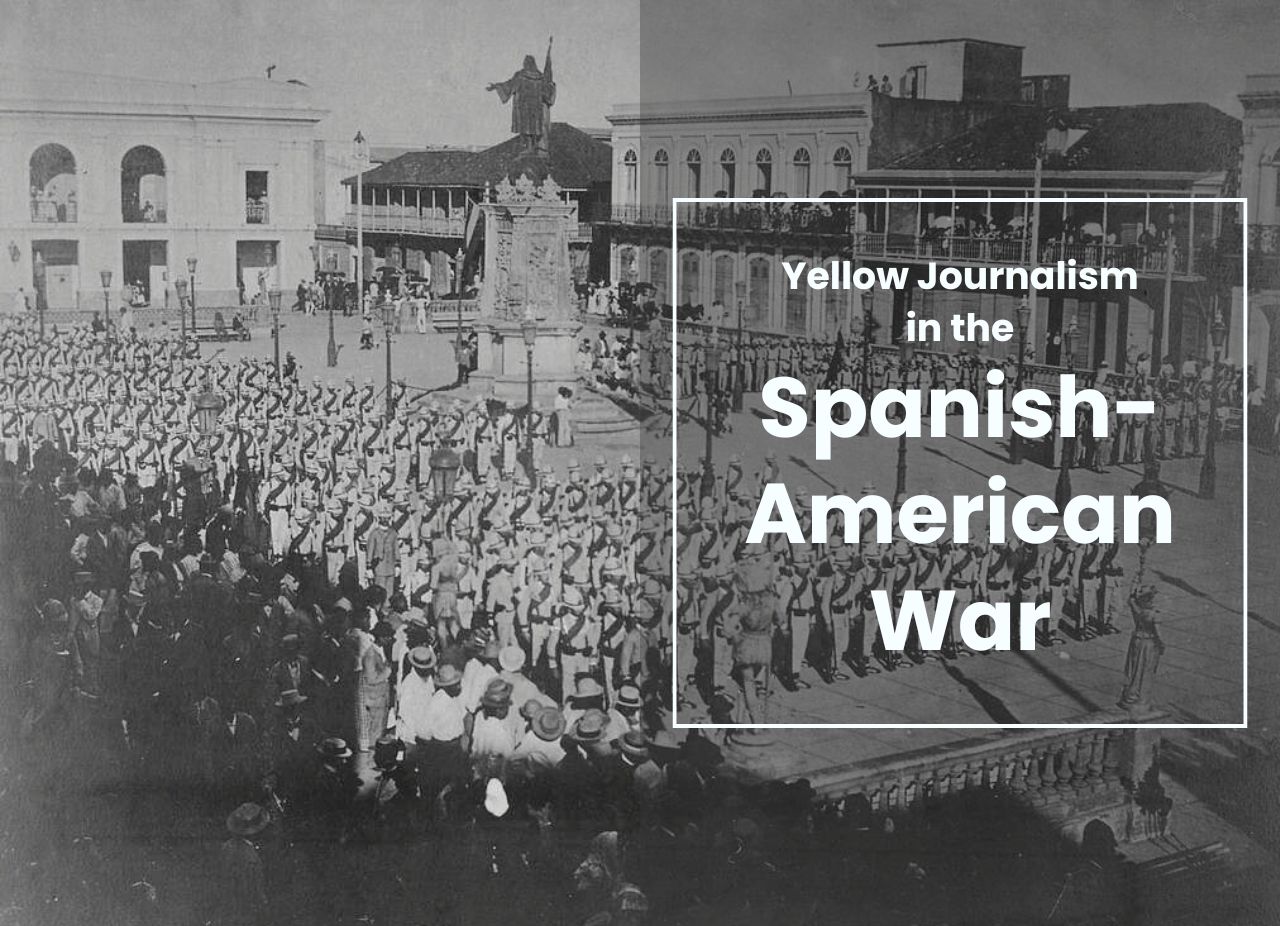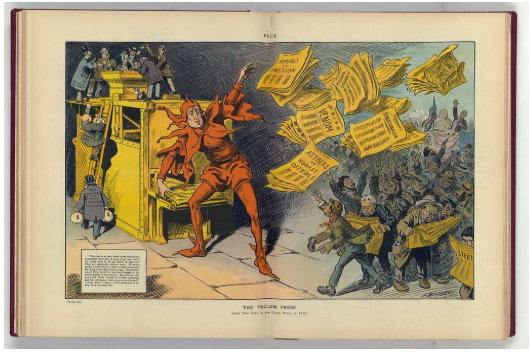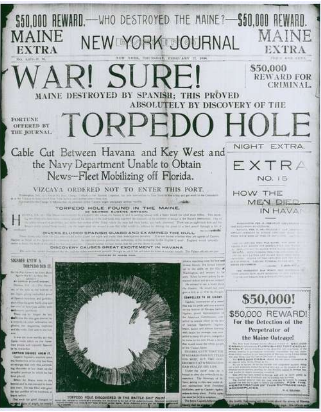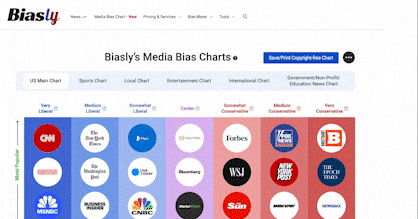
The power of the press to shape public perception has been a defining force in history, often influencing significant events. One of the most notable examples is the rise of yellow journalism during the late 19th century, particularly in the years leading up to the Spanish-American War of 1898.
Two media giants dominated this era: William Randolph Hearst, owner of The New York Journal, and Joseph Pulitzer, owner of The New York World. Their rivalry not only revolutionized newspaper publishing but also introduced a new level of media bias and journalist bias that would impact public opinion and subsequently foreign policy.
This article will explore the rise of yellow journalism. It will focus on the rivalry between Hearst and Pulitzer, the specific reporting strategies and headlines, and the substantial gap between reality and the media’s representation of events.
Defining Yellow Journalism
First, let’s clarify the meaning of yellow journalism. It is a form of sensationalism, but more narrowly defined. Yellow journalism is a more deliberate distortion of facts. It does not just twist events, it completely fabricates them. It emerged in the late 19th century and was a main tactic used in the competition between Hearst and Pulitzer.
The term “yellow journalism” originated from the popular comic strip “Hogan’s Alley,” which featured a character dressed in yellow. This originated with Pulitzer’s New York World, yet Hearst copied him and even hired the same cartoonist, R.F. Outcault, for his newspaper, The New York Journal.
Pulitzer fired back with another cartoonist and “yellow kid.” Thus, the rivalry of the “yellow kids” became a symbol of the sensationalist style that prioritized sales over truth.
As Bingfei Dong suggests, yellow journalism signaled a breakdown in the structural integrity of the news, shifting the journalist’s role from informing the public to entertaining them.

Source: The Yellow Press
Unlike traditional news, which aimed to objectively report events, yellow journalism blurred the lines between news and entertainment. As the rivalry between Hearst and Pulitzer intensified, headlines grew increasingly outrageous, and facts were often exaggerated or fabricated entirely.
This new form of newspaper bias transformed the media landscape. It laid the foundation for what we now recognize as source bias: when the origin of a news story influences how it’s framed.
A Brief History
To fully understand the influence of yellow journalism, it’s important to consider the broader historical context. At the time, the United States had growing economic and political interests in Cuba, which was then one of Spain’s last remaining colonies in America. The U.S. invested in Cuban sugar plantations and mines, controlling a large portion of the country’s sugar industry.
In 1895, the beginning of the Cuban War of Independence led to increased instability, which threatened trade and America’s economic interests. Considering the U.S. was heavily involved with Cuba, many Americans were paying close attention to the island.
Not only out of sympathy for the Cuban people, but also due to financial considerations and proximity. The U.S. also traded heavily with Cuba, and U.S. businesses invested significant amounts in Cuba, so any unrest there put American economic interests at risk.
The Rise of Yellow Journalism + The War
As aforementioned, the phenomenon of bias in the media during this time was fueled by the intense competition between Hearst’s Journal and Pulitzer’s World. Both men were determined to dominate the New York newspaper market, leading to the so-called “circulation wars.” Each publisher pushed the limits of ethical journalism, often sacrificing truth for the sake of increasing readership.
“It was said of Hearst that he wanted New York American readers to look at page one and say, ‘Gee whiz,’ to turn to page two and exclaim, ‘Holy Moses,’ and then at page three, shout ‘God Almighty!’ – writes Edwin Diamond in his book, Behind the Times” (Kennedy, 2019).
Here are some examples of headlines that seemingly prompted “gee whiz” from the public:
- “FEEDING PRISONERS TO SHARKS”
- “CUBAN BABES STARVED BY SPAIN”
- “THE WARSHIP MAINE WAS DESTROYED BY ENEMY PLOT”
These headlines, amongst many others, frequently graced the front pages of both newspaper companies. They portrayed Spain as barbaric and cruel, while casting Cuba as an innocent victim in need of American rescue. However, there was a huge gap between reality and media reporting.
Those words were designed not just to “inform,” but to provoke outrage, sympathy, and fear. For many readers, the combination of emotionally charged headlines and dramatic illustrations made the threat feel close by and immediate.
Yes, the actual conditions in Cuba were complex, but the simplified and dramatized stories made American intervention seem both necessary and urgent. The events and happenings were already confusing, and the yellow journalistic techniques did nothing to provide clear, factual information.

Source: New York Public Library
All of this sensationalist coverage of Cuba and Spain laid the groundwork for public support and pressure for America’s involvement. Media bias during this period became a powerful driver of public opinion, which in turn placed enormous pressure on U.S. policymakers.
The tipping point came on February 15, 1898, when the USS Maine exploded in Havana Harbor, killing 266 American sailors. The cause of the explosion remains unclear to this day, but yellow journalism quickly filled in the blanks. Without waiting for an official investigation, both The New York Journal and The New York World immediately blamed Spain.
One of the most famous headlines from Hearst’s Journal read:
“Destruction of the War Ship Maine Was the Work of an Enemy!”
This bold claim, published before any factual confirmation, ignited widespread outrage and fear. Hearst is also credited with the (possibly fabricated) statement to artist Frederic Remington:
“You furnish the pictures and I’ll furnish the war.”
Hearst had sent Remington to Cuba to sketch war scenes for his newspaper. When Remington reported that there was no war to cover, Hearst’s supposed quote reveals he was willing to create whatever narrative he desired. Even if the quote is exaggerated, it still demonstrates the media’s desire at the time. They valued influence and power over truth.
Soon after, inflammatory slogans such as “Remember the Maine! To Hell with Spain!” dominated newspaper pages and public rallies.
In addition to headlines, political cartoons and graphic illustrations helped solidify the emotional responses. Hearst’s newspapers often featured dramatic and, sometimes, grotesque images of alleged Spanish atrocities, making the situation in Cuba seem dire to American readers.
These headlines and illustrations, fabricated by newspaper bias, fueled the clamor for war. The stories painted Cuba as a land of chaos and Spain as a villain, making it increasingly difficult for American politicians to resist the public’s demand for intervention.
The dramatic style of yellow journalism contributed to creating public support for the war. The United States, seemingly reluctant to enter the war, was unable to ignore the public outcry, which led to U.S. involvement, ultimately triggering the Spanish-American War.
Media Bias: Then and Now
The Spanish-American War marked a pivotal moment in the relationship between media, public opinion, and government policy. While it is essential to note that yellow journalism was not the sole cause of this war, it does demonstrate how public opinion can influence policy.
The lesson behind yellow journalism remains relevant today, serving as a cautionary tale of the enduring impact of media bias. Whether in 1898 or the current era, the media does not merely report events; it also has the power to create public pressure.
Just as Hearst and Pulitzer competed for circulation, today’s digital media outlets compete for clicks and engagement. Now, there are even more organizations to compete with; it is not just a rivalry between two newspapers.
This has increased clickbait headlines and entertaining graphics. Social media platforms, in particular, have become thriving places for unverified or sensational content during elections or international crises. All of which reveals how the essence of yellow journalism continues in new, modern-day forms.
As seen during the Spanish-American War, that pressure can significantly influence government actions and international relations. In today’s time, we should understand this power and its ability to change policies for the better.
We can see how it played a role in the Spanish-American War, and therefore understand how it can influence modern-day government policies as well. However, instead of creating public pressure through yellow journalism, we should focus on gaining influence in an ethical and credible manner.
Unfortunately, there is a significant amount of bias in the media today. We need to be aware of which sources are factual and which sources use yellow journalistic and general sensationalist techniques.
Luckily, the Media Bias Chart and Media Bias Ratings List are just some of the ways we can learn about specific news sources. By seeking reliable sources like these, we can become more informed citizens and help ensure society is influenced by truth, not distortion.























